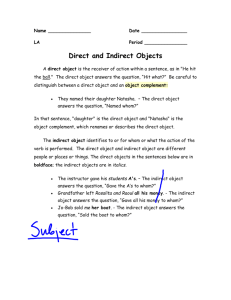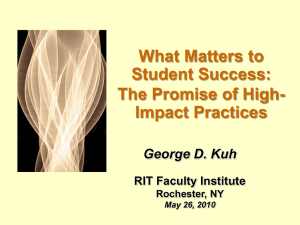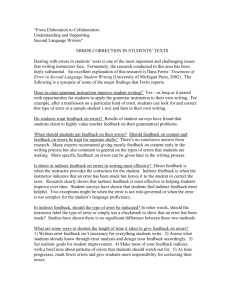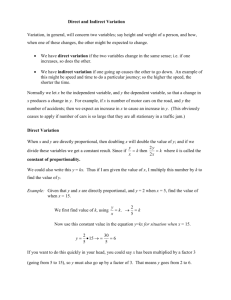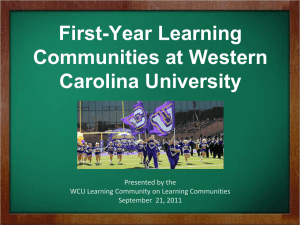Writing, Engagement, and Successful Learning Outcomes in College
advertisement
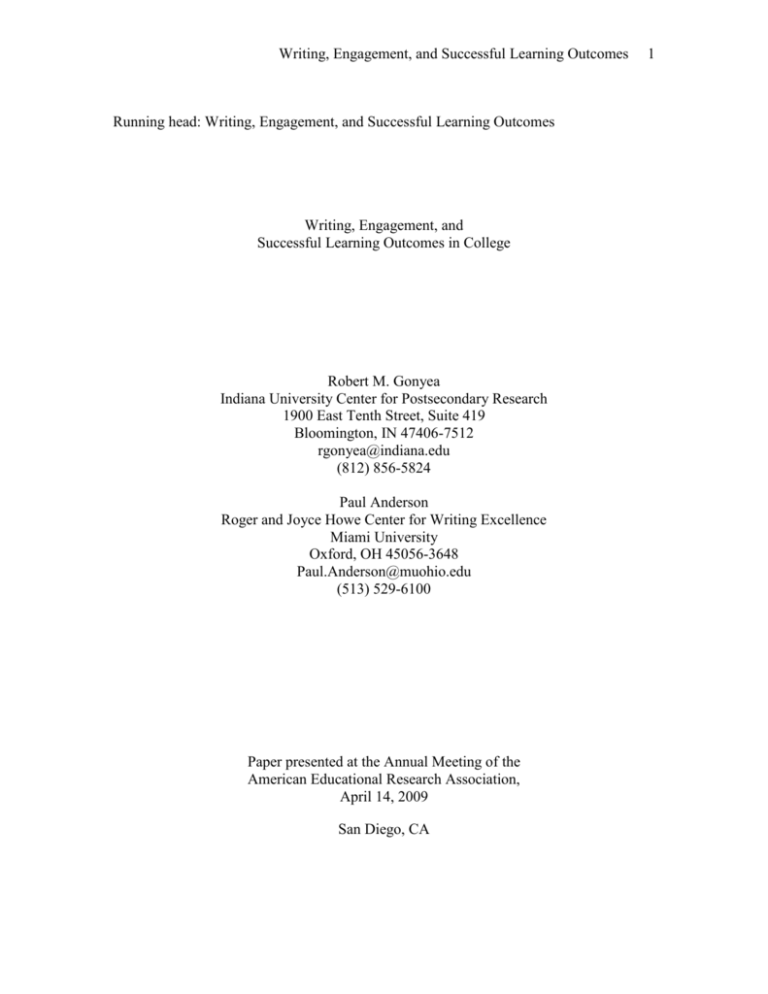
Writing, Engagement, and Successful Learning Outcomes Running head: Writing, Engagement, and Successful Learning Outcomes Writing, Engagement, and Successful Learning Outcomes in College Robert M. Gonyea Indiana University Center for Postsecondary Research 1900 East Tenth Street, Suite 419 Bloomington, IN 47406-7512 rgonyea@indiana.edu (812) 856-5824 Paul Anderson Roger and Joyce Howe Center for Writing Excellence Miami University Oxford, OH 45056-3648 Paul.Anderson@muohio.edu (513) 529-6100 Paper presented at the Annual Meeting of the American Educational Research Association, April 14, 2009 San Diego, CA 1 Writing, Engagement, and Successful Learning Outcomes 2 Abstract Writing, Engagement, and Successful Learning Outcomes in College Prominent theories of the cognitive process by which writing enhances learning lack empirical evidence. This study explores the alternative hypothesis that writing produces learning indirectly when it engages students in deep learning activities and interactions with faculty members. Using structural equation modeling on data from the 2007 administration of the National Survey of Student Engagement, it tests a model by which student writing has a causal relationship on deep learning and meaningful interactions with faculty, suggesting that it drives engagement rather than simply being one form of it. Results suggest that writing exerts its major effect on learning when it engages students in deep learning as measured by higher order, integrative, and reflective learning activities. No such effects were found for student-faculty interaction. These findings can serve as the basis for increasing the effectiveness of collegiate writing programs. Writing, Engagement, and Successful Learning Outcomes 3 Writing, Engagement, and Successful Learning Outcomes in College Demands for higher education to improve student learning come from both within and outside the academy, including the federal government. Yet, while there is a clamoring about accountability for U.S. higher education “…there has been a near-total public silence about what contemporary college graduates need to know and be able to do” (AAC&U, p. 7). Process indicators that measure student engagement have emerged as a hopeful source of evidence of student success and institutional quality (Kuh, 2001). Even when rich evidence of outcomes exists, process indicators are able to guide institutions toward programs, processes, activities, and student efforts that produced those outcomes (Banta, 2002). To more fully develop student talents, many campuses are shifting from a passive, instructor-dominated pedagogy to active, learner-centered activities. Because writing is seen as a “minds on,” active-learning activity, one result has been an increase in expectations for the teaching and learning of writing. Advocates of writing across the curriculum (WAC) programs often talk about two kinds of writing assignments: those whose goal is learning to write and those that involve writing to learn (McLeod & Miraglia, 2001). Empirical research into the underlying premise of writing to learn has focused on two questions: Does writing actually promote learning? and What cognitive processes account for the (assumed) gains in learning that are achieved through writing? With regard to the first question, results have been mixed. In an evaluation of 35 studies, Ackerman (1993), found the results inconclusive, largely because of weak study designs Writing, Engagement, and Successful Learning Outcomes 4 and mismatches between the writing tasks and the measures of learning. In a metaanalysis, Bangert- Drowns, Hurley, and Wilkinson (2004) concluded that “writing can have a small, positive impact on conventional measures of academic achievement” but also found that some factors predict reduced effects; the factors include implementation in grades 6 through 8 and long writing assignments. Four major theories attempt to explain the cognitive process by which writing could enhance learning (Klein, 1999; McCutchen, 2008). The genre theory is supported by a significant amount of empirical research, while support for the other three is inferential. Genre theory hypothesizes that when writers use genre conventions to organize the content of a text, they are creating new relationships among pieces of knowledge they possess, thereby creating new knowledge. The second theory hypothesizes that writers set goals for their texts and then solve problems about the content, organization, and other features of their text in order to achieve their goals. In this problem-solving activity, they place elements of their knowledge into new relationships. The third theory, called “forward search,” hypothesizes that writers externalize ideas while writing and generate new ideas for the next portion of their text by rereading what they’ve written. The fourth theory suggests that writers create knowledge spontaneously “at the point of utterance.” An alternative to these four theories could be built on the extensive research suggesting that students engaged in “deep learning activities” are focused not only on substance but also the underlying meaning of the information. They make a personal commitment to understand the material which is reflected in using various strategies such as reading widely, combining a variety of resources, discussing ideas with others, Writing, Engagement, and Successful Learning Outcomes 5 reflecting on how individual pieces of information relate to larger constructs or patterns, and applying knowledge in real-world situations (Biggs, 1989). Deep learning activities are believed to promote the vital and authentic outcomes of broad knowledge and transferable skills that are associated with liberal learning. Another explanation of writing’s impact on learning outcomes is that it increases students’ interaction with faculty, which enhances learning. The mechanism of this enhancement is involves the feedback students receive, the modeling of academic and scholarly behaviors provided by the faculty members, and the increased motivation prompted by the students’ personal connection with the faculty member. Interactions with faculty inside and outside the classroom help students learn how experts think about and solve problems, and increase their opportunities to benefit from guidance and feedback in their coursework, academic programs, career decisions, and co-curricular endeavors. As a result, their teachers become role models, mentors, and guides for continuous, lifelong learning (National Survey of Student Engagement, 2008). Kuh and Hu (2001a) found that student-faculty interaction had positive effects on the quality of students’ efforts in other engagement activities. Modeling single-institution data from the College Student Experiences Questionnaire, Gonyea (2005) found that student-faculty interaction covaried with the amount of reading and writing students reported, and had a direct, positive relationship with the integrative learning factor, a measure similar to deep approaches to learning in the current study. The theoretical discussion above informs the conceptual model shown in Figure 1. The amount of student writing is shown to directly affect student learning outcomes as well as deep learning activities and student-faculty interaction. Deep learning activities Writing, Engagement, and Successful Learning Outcomes 6 and student-faculty interaction are also direct predictors of outcomes, and are presumed to covary with each other. To the extent that writing promotes deep learning activities and student-faculty interaction, its effect on learning outcomes is considered indirect. Not shown in the model are assumed covariates of student and institutional characteristics that would be included to control for their effects. Figure 1. Conceptual Model for Study Effects Indirect effect Deep Approaches to Learning Writing Amount Direct effect Indirect effect Gains in Learning and Development StudentFaculty Interaction Purpose The purpose of this study is to examine the effect of writing on student learning and to test empirically a conceptual model of the means by which writing contributes to student learning. Specifically, the following research question guides the study: What are the direct, indirect, and total effects of the amount of writing on engagement in deep learning and student-faculty interaction, and on self-perceived learning outcomes? Writing, Engagement, and Successful Learning Outcomes 7 Methods The primary analytical method employed by the study is structural equation modeling (SEM) (Bentler, 1995; Byrne, 1994). SEM allows a researcher to hypothesize causal relationships among the variables, express those relationships in a series of equations, and simultaneously test the fit of this system of equations to the actual data. Using SEM, it is possible to estimate the total effects of writing as the sum of both direct and indirect effects on students’ gains in student learning and development. In addition, whereas other multivariate procedures are not able to assess or correct for measurement error, SEM allows the researcher to explicitly estimate error and thus cordon off these error estimates in the final analysis. When traditional regression methods are employed, variables are assumed to be without error, and as a result, true scores are confounded with measurement error (Pike, 1991). The standard goodness-of-fit measure for analyzing structural models is the chisquared statistic, a measure of the comparison between the actual data and the model representation of the data. However, because chi-squared values are strongly influenced by sample size, the Comparative Fit Index (CFI) is a preferred alternative because it takes sample size into account (Byrne, 1994). Values of the CFI range from 0.00 to 1.00, and current standards for acceptable fit suggest that it should exceed .90 for an acceptable fit, and .95 for models considered to fit very well (Byrne, 1994). Boomsma (2000) also recommends a misfit index known as the Root Mean Square Error of Approximation (RMSEA). The RMSEA score should be equal to or below .10 for a good fit and below .05 for the models considered to fit well. Writing, Engagement, and Successful Learning Outcomes 8 Data Sources The data for the study come from over 231,000 full-time students enrolled at 586 baccalaureate colleges and universities in the U.S. who completed the National Survey of Student Engagement (NSSE) in 2007. Forty-seven percent were first-year students and the remaining 53% were seniors. Approximately 65% of the students in the study were female, and 74% identified as White, 5% Asian or Pacific Islander, 7% Black or African American and 6% Latino. Students were mostly of traditional age, with 91% of first-year students under 20 years and 79% of the seniors under 24 years. Students were evenly divided among the disciplines, with majors in arts and humanities (16%), business (15%), and social sciences (15%) being most common. Fifty-nine percent of the 586 institutions were private, but enrolled 50% of the students in the sample. About 37% of the institutions were rated in terms of selectivity from “Very Competitive” to “Most Competitive” (Barron’s), and these enrolled 48% of students in the sample. Variables Writing amount is represented in this study as the estimated total number of pages written by the student in the academic year. The total is estimated from student responses to three NSSE questions which ask about the number of written papers or reports of ‘20 pages or more,’ ‘between 5 and 19 pages,’ and ‘fewer than 5 pages.’ For each student the number of pages is drawn from the midpoints of the response ranges and summed across the three items. It is understood that this calculation is not likely to be an accurate estimate of how much any individual student wrote, but with thousands of cases in the data the calculation produces a reasonable and normally-distributed estimate of total written pages in the aggregate. This approach takes the stance that the quantity of student Writing, Engagement, and Successful Learning Outcomes 9 writing is a function of high expectations and the result of promoting writing throughout the curriculum. The approach is consistent with findings by Kuh (2007) and Light (2001) that the amount of writing students do has a positive relationship on student learning. Deep approaches to learning are represented as a latent factor measured by three engagement scales: Higher order learning activities include activities that require students to utilize higher levels of mental activity such as analysis and synthesis. Integrative learning activities require students to combine and assimilate knowledge and experiences meaningfully. Reflective learning activities ask students to explore their experiences of learning and better understand how they learn. Student-faculty interaction is represented in the model as a latent construct measured by student responses to four questions about the frequency with which they met with faculty about grades, talked about career plans, received feedback on their coursework, and worked with faculty on other projects outside of the classroom. Learning outcome measures include two latent constructs measured by students’ self-perceptions of the amount of progress they have made in college within two distinct areas of development. The first, Gains in General Education Learning, measures the amount students report that their experiences at their institution has contributed to their gaining a broad general education, including their ability to write and speak clearly and effectively, and to think critically and analytically. The second, Gains in Personal & Social Development, includes students’ reports about the amount their experiences at their institutions has contributed to their development in learning independently, understanding themselves, understanding other people, developing a personal code of values and ethics, and contributing to their communities. Writing, Engagement, and Successful Learning Outcomes 10 The conceptual model in Figure 1 was tested separately for first-year students and seniors for each of the two gains scales. Thus, four separate models were fit to the data for analysis. Finally, all estimates were adjusted by four key student and institution variables that are known to have effects on engagement: gender, major, enrollment in a private institution, and the selectivity rating of the student’s institution. SEM analyses were conducted on separate first-year and senior covariance matrices that were created using these key control variables. Results Four models were fit to the data as described above and examined for overall fit. All of the paths in the conceptual model in Figure 1 were statistically significant in all four models, and were thus not removed for fit purposes. A small number of covariances were estimated within the measurement models for latent factors in order to improve model fit, but only when a review of item content indicated a reasonable connection between the items. Thus, with minimal corrections, model fit indices (Table 1) indicate that the models fit the data very well (Boomsma, 2000). For all four models, the Comparative Fit Index is over .95, and the RMSEA is at the.05 threshold. Table 1: Model Fit Indices Models Gains in General Education Gains in PersonalSocial Development First-Year Senior Comparative Fit Index (CFI) .97 .96 Root Mean-Square Error of Approximation (RMSEA) .05 .05 First-Year Senior .96 .96 .05 .05 Writing, Engagement, and Successful Learning Outcomes 11 Table 2 shows, in standardized coefficients, the direct effects of the writing amount variable on the gains scales and the indirect effects of writing on deep learning and student-faculty interaction for both first-year students and seniors. These direct and indirect effects are summed to create total effect sizes of .16 and .12 for first-year students, and .18 and .14 for seniors. Writing amount had positive direct effects on both mediator variables, with modest effects on deep approaches to learning (.28 for first year students and .32 for seniors) and somewhat smaller effects on student-faculty interaction (.20 for both first-year students and seniors). In all four models, student interactions with faculty had small or trivial effects on the gains factors, and in one case was negative. On the other hand, deep approaches to learning had strong effects in between .50 to .70 on the gains factors. This may be because after removing the variance explained by deep learning in that portion of the model, student-faculty interaction no longer explained remaining variance. Thus, it appears that deep approaches to learning are perceived by students to have a greater impact on their learning and development than close interactions with faculty. The indirect effects of writing amount on both general education learning and personal and social development are substantially greater than the direct effects of writing amount on the outcome measures. In fact, the direct associations are trivially negative after taking into account the control variables and the two engagement constructs. Because of the strong effects observed for deep learning and weak effects for studentfaculty interactions, the magnitude of these indirect effects of writing amount is clearly due to the relationship of writing to deep learning. Writing, Engagement, and Successful Learning Outcomes 12 Table 2. Direct and Indirect Effects of Writing on Self-Reported Gains in General Education First-Year Students Direct Effects on: Mediator Variables Indirect Effects of Writing Amount on: Direct Effects of Writing Amount on Mediators General Education Learning PersonalSocial Development General Education Learning PersonalSocial Development a b b a*b a*b Deep Approaches to Learning .28 .69 .52 .19 .15 Student-Faculty Interaction .20 -.04 .12 -.01 .02 -.03 -.05 Sum of Indirect Effects of Writing Amount .19 .17 Total Effects of Writing Amount (Direct + Indirect) .16 .12 Writing Amount Seniors Direct Effects on: Mediator Variables Indirect Effects of Writing Amount on: Direct Effects of Writing Amount on Mediators General Education Learning PersonalSocial Development General Education Learning PersonalSocial Development a b b a*b a*b Deep Approaches to Learning .32 .65 .49 .21 .16 Student-Faculty Interaction .20 .01 .13 .00 .03 -.03 -.04 Sum of Indirect Effects of Writing Amount .21 .18 Total Effects of Writing Amount (Direct + Indirect) .18 .14 Writing Amount Writing, Engagement, and Successful Learning Outcomes 13 Discussion The most important conclusion to be drawn from the results overall is that the writing that contributes most substantially to learning is the writing that engages students in deep learning activities, which in our model are measured by three variables – higher order learning, integrative learning, and reflective learning. Modeling writing merely as a direct predictor of the outcomes variables, as would be done in single equation OLS regression, does not contribute to an understanding of the relationships among the items. On the other hand, the models consistent with Figure 1, where writing has a causal relationship with other forms of engagement and an indirect effect on learning outcomes, fit very well. What’s more, these are clear and convincing in their interpretation. That is, the more students are asked to write in ways that involve deep learning activities, the more the writing enhances their learning and development. Thus, the amount and kind of writing function as leverage points by positively influencing deep learning, which, in turn, has a positive impact on the gains factors. This understanding of the meaning and direction of the causal relationship of writing on student learning is justified because students do the kind of writing that is assigned by their instructors. This is an important point because the amount and kind of writing students do for their courses are variables that faculty and institutions can directly affect. It may be as simple as “expect more and you get more.” Increasing expectations for written work prompts students to engage more often and more deeply in the work of their learning, which leads them to learn and succeed. Writing, Engagement, and Successful Learning Outcomes 14 The results also suggest support for some elements of three of the four currently prominent theories of the cognitive processes by which writing enhances learning. The genre-based theory and the problem-solving theory both identify the reorganization of existing knowledge as one mechanism by which writers create knowledge. The forward search model also suggests that examining relationships already expressed in text provides the impetus for developing the new relationships that the writer will next record. The only current theory not supported by this study’s results is that writing promotes learning at the always-moving point in time when the writer is forming the text. Compared with the indirect effects that writing amount has on learning because it engages student in deep learning activities, the indirect effect it has by increasing studentfaculty interaction is trivial. Importance of the Study This study contributes to the understanding of writing to learn in at least four significant ways. First, the study provides empirical evidence that writing enhances student learning by driving important forms of student engagement such as those related to deep learning. Second, the study’s findings can serve as the basis for specific, evidence-based recommendations to faculty and administrators desiring to increase the effectiveness of collegiate writing programs. Third, it provides the foundation for an alternative model for understanding the cognitive processes by which writing promotes learning for college students. Fourth, in contrast to earlier studies, which define learning in terms of retention of specific facts from specific courses or parts of courses, this study demonstrates the impact of writing that engages students’ in deep learning activities on the broader outcomes of higher education, including personal and social development and Writing, Engagement, and Successful Learning Outcomes 15 acquisition of the higher-order thinking skills that are transferable to novel situations. The most important conclusion to be drawn from this study is that it isn’t the amount of writing that matters when it comes to achieving the higher-order learning outcomes desired by colleges and universities. Instead, it’s the amount of writing that promotes deep learning. Results of this study lead directly to two questions: What kinds of writing assignments are most effective at promoting deep learning? and What, if anything, can faculty and institutions do to maximize the learning students gain from those assignments? References AAC&U (2005). College Learning for the New Global Century, A report from the national leadership council from Liberal Education & America’s Promise. Washington, DC: Author. Bangert-Drowns, R.L., Hurley, M. M. & Wilkinson, B. (2004). The effects of school-based writing-to-learn interventions on academic achievement: A meta-analysis. Review of educational research. 74, 7, pp. 29-58. Banta, T.W. (2000). Assessment update: Progress, trends, and practices in higher education. San Francisco: Jossey-Bass. Barron’s Profiles of American Colleges (2006). Hauppage, NY: Barron’s Educational Series. Bean, J. C. (2001). Engaging ideas: The professor's guide to integrating writing, critical thinking, and active learning in the classroom. San Francisco: Jossey-Bass. Bentler, P. M. (1990). Fit indexes, Lagrange multipliers, constraint changes, and incomplete data in structural models. Multivariate Behavioral Research, 25, 163-172. Bentler, P. M. (1995). EQS structural equations program manual. Encino, CA: Multivariate Software, Inc. Biggs, J. B (1989). Approaches to the enhancement of tertiary teaching. Higher education research and development. 8, 7-25. Writing, Engagement, and Successful Learning Outcomes 16 Boomsma, A. (2000). Reporting analysis of covariance structures. Structural Equation Modeling, 7(3), 461-482. Byrne, B. M. (1994). Structural equation modeling with EQS and EQS/Windows. Thousand Oaks, CA: Sage Publications. Carter, M. (2007). Ways of knowing, doing, and writing in the disciplines. CCC. 56, pp. 385- 418. Gonyea, R.M. (2005). The relationship between student engagement and selected desirable outcomes in the first year of college. Thesis (Ed. D.) – Indiana University, 2005. Klein, P. D. (1999). Reopening inquiry into cognitive processes in writing-tolearn. Educational psychology review. II 3, 203-270. Kuh, G. D. (2001). Assessing what really matters to student learning: Inside the national survey of student engagement. Change, 33(3), 10-17, 66. Kuh, G. D. (October 11, 2007). Why writing matters: Lessons from NSSE and high-performing Institutions. Paper presented at the Roger and Joyce Howe Symposium on Writing in Higher Education. Miami University, Oxford, Ohio. Leist, S.M. (2006). Writing to teach: Writing to learn in higher education. Lanham, MD: UP of America. Light, R.J. (2001). Making the most of college: Students speak their minds. Cambridge, MA: Harvard UP 2001 McCutchen, D., Teske, P. & Bankton, C. (2008). Writing and cognition: Implications of the cognitive architecture for learning to write and writing to learn. In Bazerman, C. (Ed.) Handbook of research on writing: History, society, school, individual, text. New York: Erlbaum. McLeod, S.H. & Miraglia, E. (2001). Writing across the curriculum in a time of change. In McLeod, S. H., Miraglia, E., Soven, M., & Thaiss, C. (Eds.) WAC for the new millennium. Urbana, IL: National Council of Teachers of English. National Survey of Student Engagement. (2008). The NSSE 2008 Annual Results. Promoting Engagement for All Students: The Imperative to Look Within. Bloomington, IN: Center for Postsecondary Research, Indiana University School of Education. Newell, G. E. (2006). Writing to learn: How alternative theories of school writing account for student performance. In Handbook of writing research. Eds. C. A. MacArthur, S. Graham & J. Fitzgerald. New York: Guilford. Writing, Engagement, and Successful Learning Outcomes 17 Pascarella, E. T., & Terenzini, P. T. (2005). How college affects students: A third decade of research. San Francisco: Jossey-Bass. Pike, G. R. (1991). The effects of background, coursework, and involvement on students' grades and satisfaction. Research in Higher Education, 32(1), 15-30. Ramsden P. (2003). Learning to teach in higher education, New York: Routledge. Whited, A.M. (2005). Nonfiction writing prompts for geometry. Englewood, CO: Advanced Learning.



